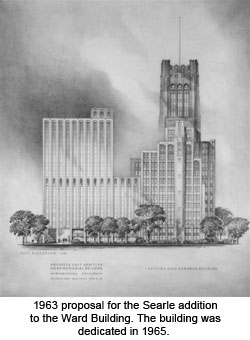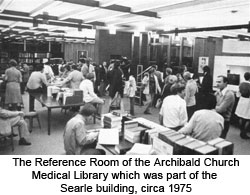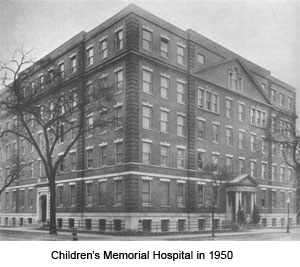This article was featured in Library Notes #62 (March 2010).
By: Ron Sims, Special Collections Librarian
This is the fourth and final installment in a multi-part series on the history of Northwestern University's medical school.
Medical School Growth and Curriculum Development in the Mid to Late 20th Century

The 1950s and 1960s saw major changes to both the medical school curriculum and the campus landscape. The addition of full-time faculty and staff to the clinical departments, along with simultaneous growth in the research commitments of the clinical and basic sciences departments, necessitated the expansion of the medical school’s research facilities. The Searle Building was dedicated on May 18, 1965. Named for John G. Searle, Chairman of the Board of Trustees of the University, this new structure contained a floor area in excess of 170,000 square feet. Financed by a grant from the National Institutes of Health, as well as by additional gifts and grants from various foundations, corporations and individuals, the new building provided one of “the finest medical teaching facilities available anywhere and [would] give new impetus to our research and medical education programs,” according to then University President, J. Roscoe Miller. The Searle Building contained more net usable space than previously available in the Ward Building and also provided needed space for an expanding medical library. The reality of the envisaged comprehensive medical center began to take shape.
 In 1956 the curriculum was significantly revised. The number of lectures were reduced while a junior clerkship and more electives were added. The Honors Program in Medical Education began in 1961, allowing highly capable men and women to enter a two year pre-medical program followed by the four year MD program. Beginning with the academic year 1965-66 the curriculum was again substantially revamped and brought in line with newer concepts in medical education. The changes involved the presentation of much of the first year coursework in an interdisciplinary fashion. Cell biology was the major course in the first session which also included biochemistry, microscopic anatomy, microbiology and some elements of pathology, physiology and pharmacology in the framework of the biology of the cell. The second session included tissue biology and the traditional gross anatomy. The third session of the year expanded the multidisciplinary approach to a more organ-oriented program in neurobiology and an interdisciplinary course in immunology. All three sessions included a course called Introduction to Clinical Medicine.
In 1956 the curriculum was significantly revised. The number of lectures were reduced while a junior clerkship and more electives were added. The Honors Program in Medical Education began in 1961, allowing highly capable men and women to enter a two year pre-medical program followed by the four year MD program. Beginning with the academic year 1965-66 the curriculum was again substantially revamped and brought in line with newer concepts in medical education. The changes involved the presentation of much of the first year coursework in an interdisciplinary fashion. Cell biology was the major course in the first session which also included biochemistry, microscopic anatomy, microbiology and some elements of pathology, physiology and pharmacology in the framework of the biology of the cell. The second session included tissue biology and the traditional gross anatomy. The third session of the year expanded the multidisciplinary approach to a more organ-oriented program in neurobiology and an interdisciplinary course in immunology. All three sessions included a course called Introduction to Clinical Medicine.
In 1966, the Northwestern University Medical Center was organized as a separate legal entity, with seven hospitals which had become affiliated with the University during the previous sixty-six years (years of affiliation in parentheses): Chicago Wesley Memorial Hospital (1899), Passavant Hospital (1925), Children’s Memorial Hospital (1946), Evanston Hospital (1950), Rehabilitation Institute of Chicago (1960), and the Chicago Maternity Center (1966). The purpose of the Medical Center, as outlined in the charter of incorporation, was “to foster joint effort to provide centralized facilities and to improve teaching, research and patient care within the existing framework of private medicine and independently operated institutions."
Generous gifts in 1966 and 1972 from Mr. and Mrs. Foster McGaw gave additional momentum to the Center, which was renamed the McGaw Medical Center of Northwestern University. An MD/PhD program, known as the Medical Scientist Training Program, was initiated in 1968. In 1973, an agreement with the City of Chicago enabled the purchase of land which had previously housed a city parking garage. The Health Sciences Building, housing the Olson and McGaw Pavilions, was constructed on this block and completed in 1978. The Dental School clinics were located in the McGaw Pavilion until 2001. In 2004, the building was remodeled to provide additional space for clinical education, labs, and the Daniel Hale Williams Auditorium. The Robert H. Lurie Cancer Center is now in the Olson Pavilion, former home of the emergency and critical care departments.
In 1990, the Integrated Graduate Program (IGP) was established as an umbrella program for PhDs in both the basic sciences and clinical departments at the Feinberg School of Medicine. The program was created to provide interdisciplinary training in modern biomedical sciences. Students could choose to study within a variety of specializations such as cancer biology, pathology and neurobiology. Other programs have since been initiated, including MD/Master of Medical Humanities and Bioethics, MD/Master of Public Health, MD/Master of Science in Healthcare Quality and Patient Safety, and Master in Medical Informatics, in addition to a number of post-doctoral fellowship programs.
The Tarry Research and Education Building was completed in 1990. It was named in honor of Edwina Tarry and George W. Tarry, MD, who were major benefactors of the Feinberg School and the School of Education and Social Policy at Northwestern University.
A generous gift from Jack and Dollie Galter provided funds for the restoration and expansion of the medical school library. In March 1996, upon completion of the project, the medical and dental school libraries were merged and became the Galter Health Sciences Library.
In April 2005, the Robert H. Lurie Medical Research Center was dedicated, providing an additional 200,000 net square feet of research space for the medical school. The twelve story Center is located on the corner of Superior Street and Fairbanks Court, site of the former Passavant Hospital. It was designed to encourage basic, clinical, and translational researchers to collaborate across disciplines, thus creating the potential for novel solutions to scientific challenges. Ann Lurie's gift to Campaign Northwestern supported the building's construction, named in honor of her late husband, Robert H. Lurie.
Campus Hospitals and Affiliated Institutions
Planning and reorganization between the University and its member hospitals were given new focus with the formalization of the relationships between the various institutions of the McGaw Medical Center. Passavant and Wesley Hospitals responded by merging nursing schools, exchanging staff privileges, and combining clinical areas, culminating in the consolidation of the two hospitals on September 1, 1972, with a new name: Northwestern Memorial Hospital. In the 1970s, the Hospital also merged with Prentice Women's Hospital and Maternity Center and the Institute of Psychiatry. The Olson Critical Care Pavilion opened in 1979.
In 1988, extensive planning for a new hospital building began in partnership with Northwestern Memorial Hospital, Northwestern University and the Northwestern Medical Faculty Foundation. Ground was broken for the new hospital in 1994 on a site bordered by Fairbanks Court and St. Clair, Huron and Erie Streets. On May 1, 1999, Northwestern Memorial opened its new healthcare facility.
Following the move to the new hospital, the previous structures were slated for demolition as part of a comprehensive campus master plan. The Robert H. Lurie Medical Research Center was built on the site of the old Passavant Hospital, greatly expanding biomedical research at the Feinberg School. The Wesley Hospital site is now home to the new Prentice Women's Hospital and Maternity Center.
Children's Memorial Hospital
 Located in Lincoln Park, Children's Memorial Hospital was founded in 1882 by Julia Foster Porter as the Maurice Porter Memorial Hospital in an 8-bed cottage at the corner of Halsted and Belden streets. It was the first hospital in Chicago dedicated solely to the care of children and pediatrics. As the primary pediatric teaching hospital of the Feinberg School, CMH is one of the country's most sought-after pediatrics residency programs. CMH is also home to the Children's Memorial Research Center, the research arm of Children's Memorial Hospital and a virtual center for pediatric research at the Feinberg School of Medicine.
Located in Lincoln Park, Children's Memorial Hospital was founded in 1882 by Julia Foster Porter as the Maurice Porter Memorial Hospital in an 8-bed cottage at the corner of Halsted and Belden streets. It was the first hospital in Chicago dedicated solely to the care of children and pediatrics. As the primary pediatric teaching hospital of the Feinberg School, CMH is one of the country's most sought-after pediatrics residency programs. CMH is also home to the Children's Memorial Research Center, the research arm of Children's Memorial Hospital and a virtual center for pediatric research at the Feinberg School of Medicine.
The ground breaking for the new children’s hospital occurred in 2008 -- the patient care wing of Children's Memorial Hospital will soon move to the Chicago Campus. The new building is scheduled to open in 2012 as the Ann & Robert H. Lurie Children's Hospital and will undoubtedly build on its existing partnerships with the Feinberg School and Prentice Women's Hospital.
Rehabilitation Institute of Chicago
In 1954, the Rehabilitation Institute of Chicago was established in an old warehouse in Chicago that was purchased and converted into a small, reasonably-equipped rehabilitation center. Dr. Paul Magnuson, orthopedic surgeon and medical school faculty member was its founder. In 1974, the Institute opened its hospital on Superior Street. Today, RIC has expanded further and now functions as rehabilitation care system with locations throughout the Chicago metropolitan area and the midwest. RIC has grown into a model institution with an international reputation for excellence. With the Feinberg School’s department of Physical Medicine and Rehabilitation, RIC offers one of the largest residency programs in its field.
And finally...
On May 14, 2009, the Feinberg School conferred 167 MD degrees. We've come a long way since the first annual commencement of the Feinberg School’s founding body, the Medical Department of Lind University. That first commencement took place 150 years ago on March 5, 1860 and the graduating class consisted of nine men.
As we look forward to the 200th anniversary of the Feinberg School in 2059, what developments and changes will be in store?
Updated: September 24, 2023